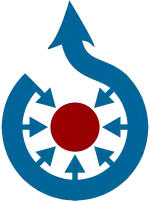Avetheropoda
Avetheropoda („ptačí teropodi“) je početná skupina teropodních dinosaurů z kladu Tetanurae, zahrnující většinu jejich odvozených druhů a také všechny současné i vyhynulé ptáky.[1] Poprvé se objevují během spodní až střední jury (asi před 176 miliony let) a přežívají až do současnosti.[2]
Stratigrafický výskyt: Střední jura – recent, před 176 miliony let – současnost | |
|---|---|
 Kostra druhu Tyrannosaurus rex, zástupce kladu. | |
| Vědecká klasifikace | |
| Říše | živočichové (Animalia) |
| Kmen | strunatci (Chordata) |
| Třída | plazi (Sauropsida) |
| Nadřád | dinosauři (Dinosauria) |
| Řád | plazopánví (Saurischia) |
| Podřád | Theropoda |
| Infrařád | Avetheropoda Paul, 1988 |
| Některá data mohou pocházet z datové položky. | |
Klasifikace

Tento taxon stanovil americký badatel Gregory S. Paul v roce 1988[3], jako klad byl poprvé ustaven Kevinem Padianem a Philipem J. Curriem v roce 1997, a to jako taxon zahrnující všechny ptáky, rod Allosaurus a veškeré jejich společné vývojové předky. Jméno "ptačí teropodi" odkazuje k množství anatomických rysů, které mají neptačí teropodní dinosauři z této skupiny společného s ptáky (nejsou-li ještě přímo zástupci skupiny Aves).[4]
V roce 1999 publikoval paleontolog Paul C. Sereno jméno jiného kladu Neotetanurae, pro klad zahrnující skupiny Allosauroidea a Coelurosauria, nikoliv ale další tetanury, jako jsou zástupci skupiny Megalosauroidea.[5] Tato definice však byla publikována později a není tedy v platnosti.
V současnosti jsou do tohoto kladu řazeny taxony Gasosaurus, Carnosauria a Coelurosauria, přičemž sem patří i skupina Megaraptora jako incertae sedis (skupina s nejistým fylogenetickým postavením).
Kladogram
Grafické znázornění klasifikace dle Rauhut a Pol, 2019[6]:
| Orionides |
| |||||||||||||||||||||||||||||||||||||||||||||||||||||||||||||||
Odkazy
Reference
- SOCHA, Vladimír. Žijí dinosauři všude kolem nás?. OSEL.cz [online]. 6. září 2019. Dostupné online. (česky)
- Zanno, L. E.; Makovicky, P. J. (2013). "Neovenatorid theropods are apex predators in the Late Cretaceous of North America". Nature Communications. 4: 2827. doi: 10.1038/ncomms3827
- Paul, G. S. (1988). Predatory Dinosaurs of the World. New York: Simon & Schuster. ISBN 0-671-61946-2.
- Apesteguia, S.; Smith, N. D.; Valieri, R. J.; Makovicky, P. J. (2016). An unusual new theropod with a didactyl manus from the Upper Cretaceous of Patagonia, Argentina. PLoS One, 11(7): e0157793.
- Sereno, P. C. (1999). "The evolution of dinosaurs". Science. 284 (5423): 2137–2147. doi: 10.1126/science.284.5423.2137
- Rauhut, Oliver W. M.; Pol, Diego (2019). "Probable basal allosauroid from the early Middle Jurassic Cañadón Asfalto Formation of Argentina highlights phylogenetic uncertainty in tetanuran theropod dinosaurs". Scientific Reports. 9 (1): 18826. doi: 10.1038/s41598-019-53672-7
Literatura
- Gauthier, J. A. (1986). Saurischian monophyly and the origin of birds. pp. 1–55 In Padian, K. (ed.) The Origin of Birds and the Evolution of Flight. Memoirs of the California Academy of Sciences 8.
- Padian, K., Hutchinson, R. M., and Holtz, Jr., T. R. (1999). Phylogenetic definitions and nomenclature of the major taxonomic categories of the carnivorous Dinosauria (Theropoda). Journal of Vertebrate Paleontology 19 (1): 69–80.
- Rauhut, O. W. M. (2003). The interrelationships and evolution of basal theropod dinosaurs. Special Papers in Palaeontology 69: 1–213.
- Hendrickx, C. and Mateus, O. (2014). Abelisauridae (Dinosauria: Theropoda) from the Late Jurassic of Portugal and dentition-based phylogeny as a contribution for the indentification of isolated theropod teeth. Zootaxa, 3759(1): 1-74.
Externí odkazy
 Obrázky, zvuky či videa k tématu Avetheropoda na Wikimedia Commons
Obrázky, zvuky či videa k tématu Avetheropoda na Wikimedia Commons - Informace na webu DinoChecker (anglicky)
- Profil na databázi Fossilworks (anglicky)
_(Antwerpener_Breiftaube).jpg.webp)



